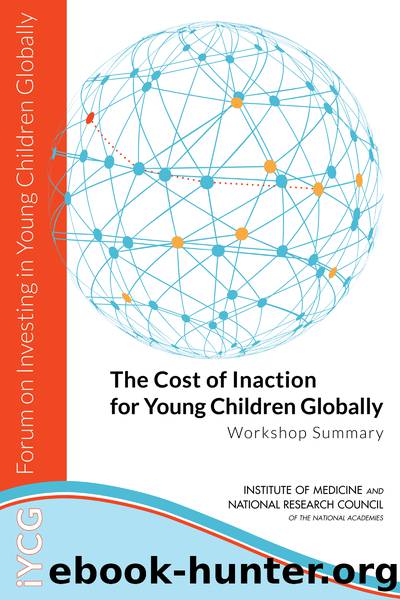The Cost of Inaction for Young Children Globally: Workshop Summary by Kimber Bogard

Author:Kimber Bogard
Language: eng
Format: epub
Tags: ebook, book
Publisher: The National Academies Press
Published: 2014-08-27T00:00:00+00:00
EARLY CHILDHOOD RIGHTS INDICATORS (ECRI): A RIGHTS-BASED APPROACH TO ENHANCING EARLY CHILD DEVELOPMENT 9
Ziba Vaghri focused on a rights-based approach to early childhood development. She began by noting that life expectancy in Burundi is 50, while life expectancy in Sweden is 81, and she presented data that indicate a correlation between average income and life expectancy. She argued that health should be a more equitable commodity.
Vaghri highlighted an effort by WHO to study the social determinants of health from 2005 to 2008, called the Commission on the Social Determinants of Health (CSDH). During this time, another effort was launched, called the Total Environment Assessment Model of ECD (TEAM-ECD). TEAM-ECD is a framework developed by the Human Early Learning Partnership (HELP), which was acting as the ECD knowledge hub for CSDH.
A specific effort to promote childrenâs development and health at the country level entered into force in 1990ânamely the Convention on the Rights of the Child, which is an international human rights treaty, and to this day 194 nations have ratified it (United Nations, 2014). Vaghri pointed out that by virtue of ratification the governments have the obligation of submitting a report on the state of the rights of their children to the United Nations Committee on the Rights of the Child (the monitoring body of CRC) every 5 years (OHCHR, 2014).
Vaghri described several articles of the convention. For example, Article 6 states the right of a child to health. Article 26 states that the government must support a child if his or her family cannot. Article 31 guarantees a child safety and security. Articles 43 to 54 discuss how to respect and protect the rights of the child internationally. She then drew the attention of the audience to the alignment between TEAM-ECD and the articles of the convention, both designed to promote childrenâs development through improving their experiences within many layers of environments surrounding them. After more than a decade of reviewing the reports from different governments, the committee observed that the majority of government reports focused primarily on the older cohorts, and that younger children were often overlooked. The reports on young children were limited to a number of health indicators (such as under-5 mortality rate) and civil rights indicators (such as birth registration), said Vaghri. In response to this discovery, General Comment 7 (GC7): Implementing CRC for Young Children was released as a comprehensive guide meant to aid governments with their reports. However, it remained underused.
In 2007, subsequent to a discussion of an international team of experts, the committee wrote a letter of invitation to HELP asking it to act as the secretariat of an ad hoc group of international experts to work on operationalizing GC7 in an attempt to make it a user-friendly guide for the governments to facilitate implementation. The result of this 7-year collaboration was a tool titled Early Childhood Rights Indicators (ECRI), which monitors the rights of young children in an integrated way, using 17 indicators. ECRI contains three categories of questions: structure related
Download
This site does not store any files on its server. We only index and link to content provided by other sites. Please contact the content providers to delete copyright contents if any and email us, we'll remove relevant links or contents immediately.
| Administration & Medicine Economics | Allied Health Professions |
| Basic Sciences | Dentistry |
| History | Medical Informatics |
| Medicine | Nursing |
| Pharmacology | Psychology |
| Research | Veterinary Medicine |
Periodization Training for Sports by Tudor Bompa(7946)
Why We Sleep: Unlocking the Power of Sleep and Dreams by Matthew Walker(6386)
Paper Towns by Green John(4826)
The Immortal Life of Henrietta Lacks by Rebecca Skloot(4274)
The Sports Rules Book by Human Kinetics(4097)
Dynamic Alignment Through Imagery by Eric Franklin(3935)
ACSM's Complete Guide to Fitness & Health by ACSM(3834)
Kaplan MCAT Organic Chemistry Review: Created for MCAT 2015 (Kaplan Test Prep) by Kaplan(3815)
Introduction to Kinesiology by Shirl J. Hoffman(3634)
Livewired by David Eagleman(3547)
The River of Consciousness by Oliver Sacks(3431)
The Death of the Heart by Elizabeth Bowen(3355)
Alchemy and Alchemists by C. J. S. Thompson(3312)
Descartes' Error by Antonio Damasio(3170)
Bad Pharma by Ben Goldacre(3118)
The Gene: An Intimate History by Siddhartha Mukherjee(2942)
The Emperor of All Maladies: A Biography of Cancer by Siddhartha Mukherjee(2942)
The Fate of Rome: Climate, Disease, and the End of an Empire (The Princeton History of the Ancient World) by Kyle Harper(2893)
Kaplan MCAT Behavioral Sciences Review: Created for MCAT 2015 (Kaplan Test Prep) by Kaplan(2832)
